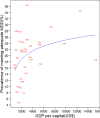Geospatial distribution and multilevel determinants of inadequate minimum dietary diversity and its consequences for children aged 6-23 months in Sub-Saharan Africa
- PMID: 40333698
- PMCID: PMC12057906
- DOI: 10.1371/journal.pone.0321254
Geospatial distribution and multilevel determinants of inadequate minimum dietary diversity and its consequences for children aged 6-23 months in Sub-Saharan Africa
Abstract
Background: Inadequate minimum dietary diversity (MMD) is the leading cause of malnutrition among young children in Sub-Saharan Africa (SSA). The evidence of geospatial distribution and multilevel determinants of inadequate MDD and its consequence among children is important for the Sustainable Development Goal (SDG0) 2030 agenda. Therefore, this study aimed to determine the geospatial distribution and multilevel determinants of inadequate MDD and its consequences among children in SSA.
Method: The study utilized recent Demographic and Health Surveys data including 57,912 children. Spatial and multilevel analyses were employed, and variables significantly associated with inadequate MDD and undernutrition with MDD consumption were assessed and significance was declared using a p-value threshold of <0.05. Adjusted odds ratio (AOR) with 95% confidence interval (CI) was reported.
Results: The prevalence of inadequate MDD was 80.3% with distinct spatial variation. Spatial distribution showed that; Gabon, Cameron, Ethiopia, Democratic Republic of Congo, Chad, Mali, Burkina Faso, Ivory Coast, Liberia, and Senegal had a very high burden of inadequate MDD. Factors like children's age, maternal age, educational status, antenatal care (ANC)/ postnatal care (PNC) visits, no media exposure, wealth status, maternal stunting and wasting, and distance from health facilities were associated with inadequate MDD in SSA. The risk of anemia, stunting, and wasting were significantly associated with inadequate MDD among children in SSA.
Conclusion: The prevalence of inadequate MDD in SSA is high. Spatial distribution revealed that inadequate MDD was prevalent in most areas of the Western, Northern, Eastern, and Central parts of SSA. Maternal and children's age, educational status, ANC/ PNC visits, no media exposure, wealth status, maternal stunting and wasting, and distance from health facilities were determinants of inadequate MDD in SSA. The spatial clustering of inadequate MDD in certain regions of SSA, suggests the need for geographically targeted interventions to address the determinants of inadequate MDD in these high-burden areas. The study revealed strategies should focus on promoting frequent ANC/ PNC visits, improving maternal nutrition, reducing poverty, and improving maternal employment status to reduce inadequate MDD among children. This study highlights a significant association between MDD and anemia, stunting, and wasting in children aged 6--23 months. To address these critical issues, it is essential to improve MDD among children, as this intervention can play a vital role in achieving SDG target 2.2, which aims to end all forms of malnutrition by 2030.
Copyright: © 2025 Hailu et al. This is an open access article distributed under the terms of the Creative Commons Attribution License, which permits unrestricted use, distribution, and reproduction in any medium, provided the original author and source are credited.
Conflict of interest statement
The authors have declared that no competing interests exist.
Figures






Similar articles
-
Multidimensional disparity in inadequate minimum dietary diversity between poor and non-poor children aged 6-23 months in Sub-Saharan Africa: a multivariate decomposition analysis.Front Public Health. 2025 Apr 2;13:1516129. doi: 10.3389/fpubh.2025.1516129. eCollection 2025. Front Public Health. 2025. PMID: 40241949 Free PMC article.
-
Dietary Diversity and Undernutrition in Children Aged 6-23 Months in Sub-Saharan Africa.Nutrients. 2021 Sep 28;13(10):3431. doi: 10.3390/nu13103431. Nutrients. 2021. PMID: 34684435 Free PMC article.
-
The effect of dietary diversity on anemia levels among children 6-23 months in sub-Saharan Africa: A multilevel ordinal logistic regression model.PLoS One. 2024 May 21;19(5):e0298647. doi: 10.1371/journal.pone.0298647. eCollection 2024. PLoS One. 2024. PMID: 38771790 Free PMC article.
-
Applied nutritional investigation spatial variation and determinants of stunting among children aged less than 5 y in Ethiopia: A spatial and multilevel analysis of Ethiopian Demographic and Health Survey 2019.Nutrition. 2022 Nov-Dec;103-104:111786. doi: 10.1016/j.nut.2022.111786. Epub 2022 Jul 1. Nutrition. 2022. PMID: 35970098 Review.
-
The association between household socio-economic status, maternal socio-demographic characteristics and adverse birth and infant growth outcomes in sub-Saharan Africa: a systematic review.J Dev Orig Health Dis. 2020 Aug;11(4):317-334. doi: 10.1017/S2040174419000680. Epub 2019 Oct 25. J Dev Orig Health Dis. 2020. PMID: 31648658
Cited by
-
Global burden of childhood developmental intellectual disability caused by iodine deficiency from 1990 to 2021 and projection to 2040.Front Public Health. 2025 Jul 9;13:1598949. doi: 10.3389/fpubh.2025.1598949. eCollection 2025. Front Public Health. 2025. PMID: 40703184 Free PMC article.
References
-
- Organization WH. Indicators for assessing infant and young child feeding practices: definitions and measurement methods. 2021.
-
- Mitchell MK. Nutrition across the life span. 2003.
-
- Eshete T. Determinants of inadequate minimum dietary diversity among children aged 6–23 months in Ethiopia: secondary data analysis from Ethiopian Demographic and Health Survey 2016. Agricult Food Security. 2018;7(1):1–8.
-
- Organization WH. WHO recommendations on maternal health: guidelines approved by the WHO Guidelines Review Committee. World Health Organization. 2017.
MeSH terms
LinkOut - more resources
Full Text Sources
Medical
Research Materials

